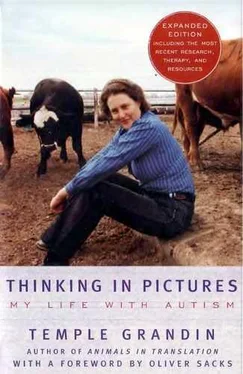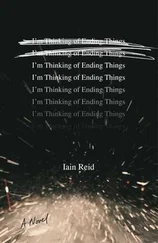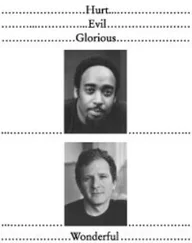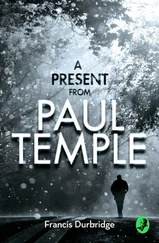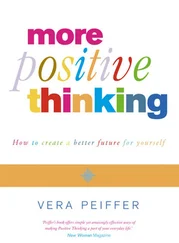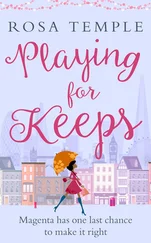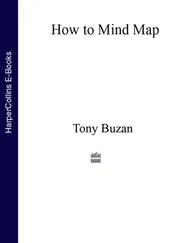More knowledge makes me act more normal. Many people have commented to me that I act much less autistic now than I did ten years ago. A person who attended one of my talks in 2005 wrote on my evaluation, «I saw Temple in 1996, it was fun to see the poise and presentation manner she has gained over the years.» My mind works just like an Internet search engine that has been set to access only images. The more pictures I have stored in the Internet inside my brain the more templates I have of how to act in a new situation. More and more information can be placed in more and more categories. The categories can be placed in trees of master categories with many subcategories. For example, there are jokes that make people laugh and jokes that do not work.There is then a subcategory of jokes that can only be told to close friends. When I was a teenager I was called «tape recorder» because I used scripted lines. As I gained experience, my conversation became less scripted because I could combine new information in new ways. To help understand the autistic brain I recommend that teachers and parents should play with an Internet search engine such as Google for images. It will give people who are more verbal thinkers an understanding into how visual associative thinking works. People with music and math minds have a search engine that finds associations between patterns and numbers.
The Asperger individual who is a verbal logic thinker uses verbal categories. For example, Dr. Minshew had an Asperger patient who had a bad side effect with a medication. Explaining the science of why he should try a different medication was useless. However, he became willing to try a new medication after he was simply told, the pink pills made you sick and I want you to try the blue pills. He agreed to try the blue pills.
The more I learn, the more I realize more and more that how I think and feel is different. My thinking is different from a normal person, but it is also very different from the verbal logic non-visual person with Asperger's. They create word categories instead of picture categories. The one common denominator of all autistic and Asperger thinking is that details are associated into categories to form a concept. Details are assembled into concepts like putting a jigsaw puzzle together. The picture on the puzzle can be seen when only 20 percent of the puzzle is put together, forming a big picture.
2
The great continuum
Diagnosing Autism
The first sign that a baby may be autistic is that it stiffens up and resists being held and cuddled. It may be extremely sensitive to touch and respond by pulling away or screaming. More obvious symptoms of autism usually occur between twelve and twenty-four months of age. I was my mother's first child, and I was like a little wild animal. I struggled to get away when held, but if I was left alone in the big baby carriage I seldom fussed. Mother first realized that something was dreadfully wrong when I failed to start talking like the little girl next door, and it seemed that I might be deaf. Between nonstop tantrums and a penchant for smearing feces, I was a terrible two-year-old.
At that time, I showed the symptoms of classic autism: no speech, poor eye contact, tantrums, appearance of deafness, no interest in people, and constant staring off into space. I was taken to a neurologist, and when a hearing test revealed that I was not deaf, I was given the label «brain-damaged.» Most doctors over forty years ago had never heard of autism. A few years later, when more doctors learned about it, that label was applied.
I can remember the frustration of not being able to talk at age three. This caused me to throw many a tantrum. I could understand what people said to me, but I could not get my words out. It was like a big stutter, and starting words was difficult. My first few words were very difficult to produce and generally had only one syllable, such as «bah» for ball. I can remember logically thinking to myself that I would have to scream because I had no other way to communicate. Tantrums also occurred when I became tired or stressed by too much noise, such as horns going off at a birthday party. My behavior was like a tripping circuit breaker. One minute I was fine, and the next minute I was on the floor kicking and screaming like a crazed wildcat.
I can remember the day I bit my teacher's leg. It was late in the afternoon and I was getting tired. I just lost it. But it was only after I came out of it, when I saw her bleeding leg, that I realized I had bitten her. Tantrums occurred suddenly, like epileptic seizures. Mother figured out that like seizures, they had to run their course. Getting angry once a tantrum started just made it worse. She explained to my elementary school teachers that the best way to handle me if I had a tantrum was not to get angry or excited. She learned that tantrums could be prevented by getting me out of noisy places when I got tired. Privileges such as watching Howdy Doody on TV were withdrawn when I had a bad day at school. She even figured out that I'd sometimes throw a tantrum to avoid going to class.
When left alone, I would often space out and become hypnotized. I could sit for hours on the beach watching sand dribbling through my fingers. I'd study each individual grain of sand as it flowed between my fingers. Each grain was different, and I was like a scientist studying the grains under a microscope. As I scrutinized their shapes and contours, I went into a trance which cut me off from the sights and sounds around me.
Rocking and spinning were other ways to shut out the world when I became overloaded with too much noise. Rocking made me feel calm. It was like taking an addictive drug. The more I did it, the more I wanted to do it. My mother and my teachers would stop me so I would get back in touch with the rest of the world. I also loved to spin, and I seldom got dizzy. When I stopped spinning, I enjoyed the sensation of watching the room spin.
Today, autism is regarded as an early childhood disorder by definition, and it is three times more common in boys than girls. For the diagnosis to be made, autistic symptoms must appear before the age of three. The most common symptoms in young children are no speech or abnormal speech, lack of eye contact, frequent temper tantrums, oversensitivity to touch, the appearance of deafness, a preference for being alone, rocking or other rhythmic stereotypic behavior, aloofness, and lack of social contact with parents and siblings. Another sign is inappropriate play with toys. The child may spend long periods of time spinning the wheel of a toy car instead of driving it around on the floor.
Diagnosing autism is complicated by the fact that the behavioral criteria are constantly being changed. These criteria are listed in the Diagnostic and Statistical Manual published by the American Psychiatric Association. Using those in the third edition of the book, 91 percent of young children displaying autistic symptoms would be labeled autistic. However, using the newest edition of the book, the label would apply to only 59 percent of the cases, because the criteria have been narrowed.
Many parents with an autistic child will go to many different specialists looking for a precise diagnosis. Unfortunately, diagnosing autism is not like diagnosing measles or a specific chromosomal defect such as Down syndrome. Even though autism is a neurological disorder, it is still diagnosed by observing a child's behavior. There is no blood test or brain scan that can give an absolute diagnosis, though brain scans may partially replace observation in the future.
The new diagnostic categories are autism, pervasive developmental disorder (PDD), Asperger's syndrome, and disintegrative disorder, and there is much controversy among professionals about them. Some consider these categories to be true separate entities, and others believe that they lie on an autistic continuum and there is no definite distinction between them.
Читать дальше
